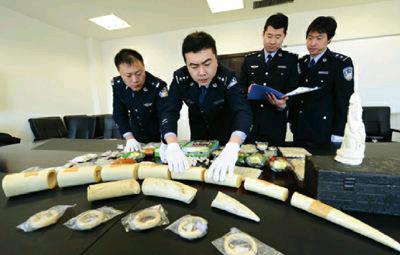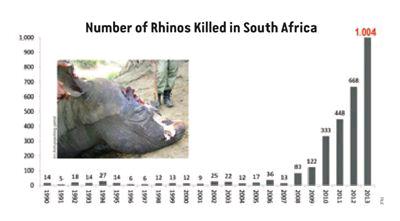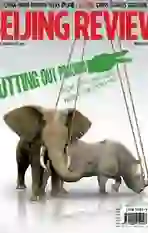UNITED FRONT FOR CONSERVATION
2014-03-04ByWangHairong
By+Wang+Hairong
A cross-continent operation against illegal wildlife trade was conducted secretly from December 30, 2013 to January 26, 2014.
The operation, code-named Cobra II, was co-organized by China, the United States, South Africa, the Lusaka Agreement Task Force (LATF), the ASEAN Wildlife Enforcement Network and the South Asia Wildlife Enforcement Network, along with the support of the Convention on International Trade in Endangered Species of Wild Fauna and Flora (CITES), the World Customs Organization and Interpol.
The global crackdown focused on key species that are subject to illegal trade and achieved “excellent” results, according to John E. Scanlon, Secretary General of the CITES.
Huge success
Operation Cobra II led to conclusions of more than 350 cases and the arrest of over 400 sus- pects. Seized illegal animal products included more than 3 tons of raw ivory and ivory products, 1,000-plus hides, 36 rhino horns and a large number of other wildlife products, according to the China Endangered Species Import and Export Management Office.
The operation was participated in by 28 countries in total, while the first Cobra operation launched a year earlier involved 22 countries.“Six more countries were involved this year, resulting in even greater cooperation,” said Wan Ziming, Director of the Law Enforcement Department with the China Endangered Species Import and Export Management Office.
According to Wan, China played a leading role in carrying out Operation Cobra II. Chinas forestry, customs, police, judiciary and quarantine authorities assigned more than 100,000 staff on the operation, and uncovered over 200 cases involving more than 350 suspects, which ended up accounting for more than half of all cases cracked.
For the first time, China sent enforcement staff to Kenya to arrest a man suspected of ivory trafficking and to host lectures on wildlife protection.
“The success of Operation Cobra II came from the coordination, cooperation and intelligence generated to combat wildlife crime syndicates,” said Bonaventure Ebayi, Director of the LATF. The task force is an inter-governmental organization with the main function of facilitating cooperative activities in/among the party states to the Lusaka Agreement, in carrying out investigations on violations of national laws pertaining to illegal trade in wild fauna and flora.
Ebayi added, “As much as the seizures of contraband were welcomed, the real impact was in the intelligence gained, networks developed and the number of investigations, arrests and prosecution of the suspects behind these illegal shipments.”endprint
Edward Grace, deputy chief of the U.S. Fish and Wildlife Services Office of Law Enforcement, said that the operation sent a powerful message to poachers and smugglers across the globe that the worlds endangered wildlife and plant resources are not theirs for the taking.
“Only as global partners can we protect the worlds wildlife,” Grace said.
Senior superintendent Uttam Kumar Karkee of the Nepal police said that this operation has proved itself an excellent model for fighting transnational crime.
Stopping trafficking
“This second Operation Cobra initiative shows what can be achieved when law enforcement authorities across range, transit and destination states work together in a coordinated manner. It also serves to highlight that intelligence-led operations are essential in the fight against transnational organized wildlife crime,” Scanlon said.
Wildlife is the worlds fourth most smuggled item, after drugs, counterfeit goods and human trafficking.
“Leaving aside timber and marine products, it is estimated that the annual value of the illegal wildlife trade is up to $20 billion and it has often been regarded as a high-profit low-risk crime—although this is starting to change as states recognize its negative economic, social and environmental impacts,” Scanlon said at the International Wildlife Trafficking Symposium held in London on February 11-12.
According to China Daily, every year, about$1 billion worth of python skins are smuggled from Southeast Asia into Europe to meet the needs of the luxury goods industry.
At least 5 percent of the wild rhinos and elephants in Africa are killed for their horns and ivory every year, usually to meet demand in Asia. On top of this, wild animals are often smuggled out of their habitats to be kept as pets.
“Wildlife trafficking is now more organized, lucrative, widespread and dangerous than ever before. We need strong partnerships to fight the global problem of illicit wildlife trafficking,” Wan said.
China is a major destination for ivory, rhino horns, pangolin scales, as well as tiger and leopard products. In China, ivory has traditionally been used in the carving of exquisite sculptures and ornaments. Rhino horns, pangolin scales and tiger bones are prized ingredients in traditional Chinese medicine. Leopard fur is loved for its attractive pattern.
To regulate trade in wildlife, China joined the CITES in 1981. The convention aims to prevent international trade from threatening the survival of wild flora and fauna.endprint
Today, CITES regulates international trade in close to 35,000 species of plants and animals, including their products and derivatives according to the conventions website.
After signing the convention, China has made significant progress in its wildlife protection efforts. In 1988, Chinas Law on the Protection of Wildlife went into effect. That year, China made it illegal to kill or sell 256 species of wild animals.
Border patrol and customs officers actively clamp down on wildlife trafficking. In addition, the government has tackled the problem online.
During the more than 30 years since joining the convention, China has actively fulfilled its responsibilities and participated in international cooperation, and played an important role in wildlife protection and trade regulation, Scanlon said at the 16th meeting of the CITESConference of the Parties in Bangkok, Thailand, last March.
Zhang Jianlong, Director of the National Interagency CITES Enforcement Collaborative Group and Deputy Director of the State Forestry Administration, said that China will continue to cooperate with other countries to strengthen wildlife protection and fully fulfil its international obligations.endprint
